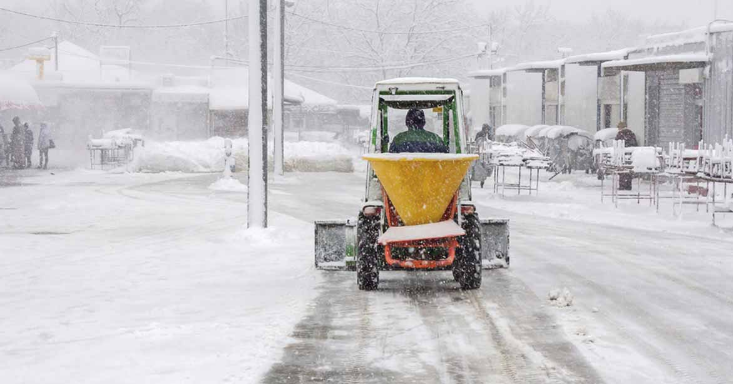When winter weather brings snow and ice, ensuring the safety of walkways, driveways, and steps becomes a priority. Two common deicing solutions—ice melt and rock salt—are widely used to combat icy surfaces, but each has its benefits and limitations. Understanding the differences between these materials can help you choose the right deicing solution for your specific needs, considering factors like effectiveness at various temperatures, environmental impact, and potential harm to surfaces.
Ice Melt vs. Rock Salt: What’s the Difference?
At the core, the main difference between ice melt and rock salt lies in their composition and how they lower the freezing point of water.
Rock Salt (Sodium Chloride)
- Temperature Efficiency: Rock salt is effective in conditions above 20°F (-6°C). Its effectiveness diminishes as temperatures drop below this point.
- Environmental Impact: It can be harmful to plants and soil due to the high sodium content and may contribute to metal corrosion and concrete damage.
- Cost: Rock salt is generally less expensive than many ice melt blends, making it a popular choice for large areas.
Ice Melt
- Composition: Ice melt products can contain a variety of chemicals, including calcium chloride, magnesium chloride, and Potassium Acetate. Some blends are designed to minimize environmental impact.
- Temperature Efficiency: Many ice melt products work at lower temperatures than rock salt, some effective down to -25°F (-32°C).
- Environmental and Surface Impact: Depending on the blend, ice melt can be safer for vegetation, concrete, and metal surfaces. Products like potassium acetate are more environmentally friendly and less corrosive.
Choosing the Right Deicing Solution
Consider the Temperature
- Rock Salt: Opt for rock salt if you’re dealing with ice in temperatures above 20°F.
- Ice Melt: In colder climates, where temperatures frequently fall below 20°F, an ice melt blend may provide more reliable deicing.
Assess the Environmental Impact
- Vegetation and Pets: If you’re concerned about plant life, pets, or local wildlife, look for eco-friendly ice melt options that contain magnesium chloride or potassium acetate.
- Surface Material: For sensitive surfaces like new concrete or decorative pavers, choose a deicing product that specifies it’s safe for such materials.
Cost vs. Effectiveness
- Budget: Rock salt may be more cost-effective for large areas where the slightly higher environmental and surface risks are manageable.
- Performance: For critical areas like steep driveways, steps, or commercial properties where safety is paramount, investing in a higher-quality ice melt product may be worth the additional cost.
Practical Application Tips
- Pre-treatment: Applying deicer before a snowstorm can prevent ice from bonding to the surface, making removal easier.
- Even Distribution: Use a spreader for granular products to ensure even coverage and avoid over-application, which can harm surfaces and the environment.
- Follow Instructions: Always read and follow the manufacturer’s guidelines for application rates and safety precautions.
Conclusion
Deciding between ice melt and rock salt depends on several factors, including the specific temperatures you’re dealing with, environmental concerns, and the types of surfaces you need to treat. While rock salt may be suitable for areas with milder winters and less concern for vegetation, ice melt products offer a more versatile and environmentally friendly solution for colder climates and sensitive areas. For more detailed comparisons and recommendations, what is ice melt provides an in-depth look at the strengths and limitations of each option, helping you make an informed decision for your winter weather needs.


